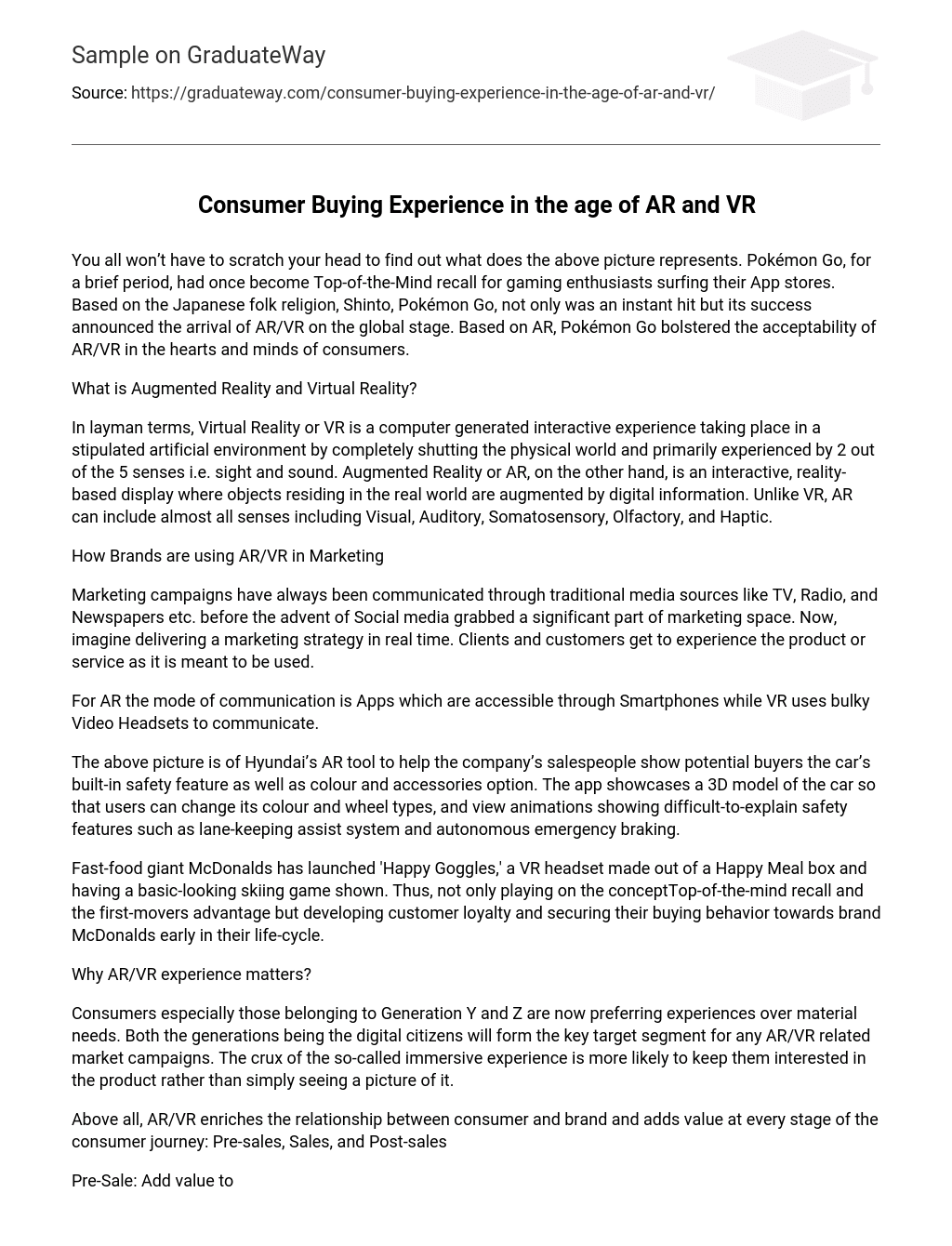You all won’t have to scratch your head to find out what does the above picture represents. Pokémon Go, for a brief period, had once become Top-of-the-Mind recall for gaming enthusiasts surfing their App stores. Based on the Japanese folk religion, Shinto, Pokémon Go, not only was an instant hit but its success announced the arrival of AR/VR on the global stage. Based on AR, Pokémon Go bolstered the acceptability of AR/VR in the hearts and minds of consumers.
What is Augmented Reality and Virtual Reality?
In layman terms, Virtual Reality or VR is a computer generated interactive experience taking place in a stipulated artificial environment by completely shutting the physical world and primarily experienced by 2 out of the 5 senses i.e. sight and sound. Augmented Reality or AR, on the other hand, is an interactive, reality-based display where objects residing in the real world are augmented by digital information. Unlike VR, AR can include almost all senses including Visual, Auditory, Somatosensory, Olfactory, and Haptic.
How Brands are using AR/VR in Marketing
Marketing campaigns have always been communicated through traditional media sources like TV, Radio, and Newspapers etc. before the advent of Social media grabbed a significant part of marketing space. Now, imagine delivering a marketing strategy in real time. Clients and customers get to experience the product or service as it is meant to be used.
For AR the mode of communication is Apps which are accessible through Smartphones while VR uses bulky Video Headsets to communicate.
The above picture is of Hyundai’s AR tool to help the company’s salespeople show potential buyers the car’s built-in safety feature as well as colour and accessories option. The app showcases a 3D model of the car so that users can change its colour and wheel types, and view animations showing difficult-to-explain safety features such as lane-keeping assist system and autonomous emergency braking.
Fast-food giant McDonalds has launched ‘Happy Goggles,’ a VR headset made out of a Happy Meal box and having a basic-looking skiing game shown. Thus, not only playing on the conceptTop-of-the-mind recall and the first-movers advantage but developing customer loyalty and securing their buying behavior towards brand McDonalds early in their life-cycle.
Why AR/VR experience matters?
Consumers especially those belonging to Generation Y and Z are now preferring experiences over material needs. Both the generations being the digital citizens will form the key target segment for any AR/VR related market campaigns. The crux of the so-called immersive experience is more likely to keep them interested in the product rather than simply seeing a picture of it.
Above all, AR/VR enriches the relationship between consumer and brand and adds value at every stage of the consumer journey: Pre-sales, Sales, and Post-sales
Pre-Sale: Add value to the shopping experience
Remove uncertainty from decision-making
Determining whether a new home appliance or a particular piece of furniture would fit well within your personal space used to be a daunting task. This is where AR apps like IKEA Place and View in Room 3D score. These interactive apps remove the uncertainty as they project the furniture or décor in 3D at full-scale by helping shoppers transform their homes into virtual showrooms.
Check what’s trending before taking the big decision
Peer influence is a strong driver for sales. Brazilian retailer C&A displays its apparel on innovative clothing hangers. As shoppers pass through the store, they can aim their smartphone app at the item, and check the number of “likes” on the particular item.
Point of Purchase: Boost Sales
Virtual dressing rooms
AR apps make shopping for apparel easier. Dressing Room by Gap allow customers to select an Apparel from the virtual shelf and then choose their clothing size. An AR-generated model tries on the clothing and can be rotated 36⁰, allowing the customer to get a better idea of how the clothes will fit.
Immersive Retail
Starbucks flagship Roastery in Shanghai is using the power of AR to transform the retail experience. Visitors use their smartphone to unlock fun visuals, gather information about products, and even learn about the roasting process. Thus, a whole version of customer involvement.
Post-Sale support: Solidify the brand-customer relationship
Self-service support
Brands are tapping into powerful AR-based self-service for upping their post-sales service game. Using a smartphone, customers can access the product related FAQs, manuals and training material displayed in an AR overlay.
Technical support
The agent-customer interactions during technical support calls can be eliminated with AR-based visual support. Visual Support allows customers to hold a smartphone near the product and all parts will be identified in real time by computer vision technology.
Conclusion
Customer relationship is changing dramatically as consumers these days are preferring experiences over material needs. The advent of AR/VR has the potential to not only become a differentiator for organizations but also take the overall customer experience to a new level. Through Apps and Video Headsets, the two upcoming technologies can be added throughout the customer value-chain i.e. Pre-sales, Sales and Post-Sales and create a unique value proposition for both organizations and customers.
References
- https://www.statista.com/chart/4602/virtual-and-augmented-reality-software-revenue/
- https://www.forbes.com/sites/forbesagencycouncil/2017/11/08/how-augmented-reality-is-changing-the-world-of-consumer-marketing/#43c1fd0254cf
- https://arvrjourney.com/augmented-world-how-ar-transforms-customer-experience-534c46b78501





